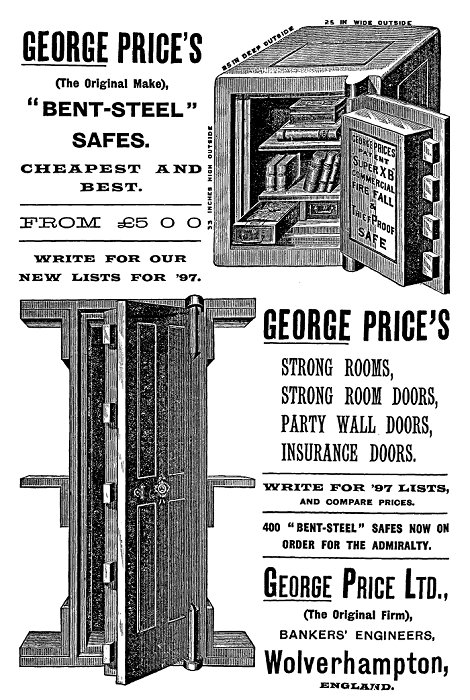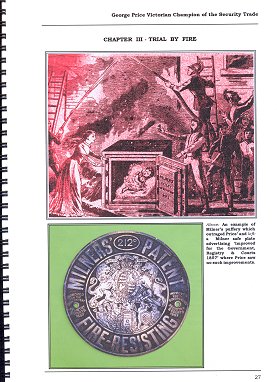page 4
Where to find a George Price safe
Because Milner bought up the only piece of land Price
might have used to extend the Cleveland Works, he never extended his
work force above thirty men. In later years, the company specialised in
building bank strong rooms. Many of these are bricked up now, out of
sight in basements under banks which have been turned into bistros and
employment agencies. George Price safes are far less common than Milners
or Chatwoods. He probably spent far too much time writing his books to
build up his works to its full potential. For that we have to be
grateful, for without Price there would be very little information on
the competition which surrounded the development of safe safes and
secure locks.
And what about William Milner, who Price saw as his torturer? My
research has shown that unknown to Price, Milner had lived much of the
time since the early 1850's in Port Erin on the Isle of Man, and was
fully absorbed in spending the fortune provided by his father's
invention on projects well away from locks, keys and safes. He was known
as 'the godfather of Port Erin'. He brought all his influence to bear on
a campaign to build a breakwater across the bay which was very
vulnerable to storms.
He set up charities to help the poverty stricken fishermen and in
1871 a tower was built out of local slate as a memorial "to his many
charities". Milner's Tower is a local landmark and stands high on Bradda
Head, impersonating a lighthouse. In fact it is built in the shape of a
key, with a spiral staircase inside. St. Catherine's church in Port Erin
was erected around 1879 with money from Milner's will.
|

An advert from 1896. |
Price died, still very prosperous, in 1887. He
and William Dawes produced first class safes, and his best ne
plus ultra
locks remain unpickable to this day. Chubb has survived,
Chatwood and Milner survived as Chatwood-Milner, while Price was
taken over by Gibbons, in 1906, and the
company name disappeared.
It seems that once George Price became
old and frail, no-one else had his fanatical drive and his sons
were not interested. Price's third son, Bertie, in charge at
the time of the takeover, worked as office manager for Gibbons
until some time during the Second World War, when he was over
eighty.
He lived in mildly distressed circumstances in a rented
house, furnished with the relics of his father's collection of
clocks, musical boxes, tapestries, stuffed squirrels and salmon
in glass cases, beautiful dressers and a creaky old safe full of Elkington
plate silver. In the attic were three large oil paintings: two
of Price and one of his father, Joseph, together
with Price's copy of his Treatise. |
| An advert from 1897. |
 |
Acknowledgements
Grateful thanks for invaluable help are due to Trevor
Dowson, Peter Scholefield, Tom Watson and Michael Chatwood.
Many of the illustrations come from the copies of George
Price's Treatises in the Wolverhampton City Archives.
Bibliography
Joseph Price A summary of Mr. Leigh 's History of the
Cholera in Bilston in 1832.Bilston, 1833. Available in Wolverhampton
City Archives
Joseph Price A Historical Account of Bilston from Alfred the Great to
1831. Published 1835. Available in Wolverhampton City Archives
George Price A treatise on fire and thief proof depositories and
locks and keys. Published by Simpkin, Marshall and
Hall, London, 1856. Available in Wolverhampton City Archives and
the British Museum. Occasionally available on internet antiquarian book
sites.
George Price Forty Burglaries of the years 1863-4-5. Available in
Wolverhampton City Archives
George Price Gunpowder Proof Locks. 1860. Reprint available from
Syd Waterman, email: syd@lockcollectors.com
Barnsby, G. The working class movement in the Black
Country 1750-1867. Wolverhampton, 1977
Burritt, E. Walks in the Black Country and its green surroundings.
Published circa 1870, reprinted by Roundwood, 1976. (Burritt was the
American Consul)
Clare, A.C. The Chatwood Story. A.C.Clare, 1999
Hackwood, F. The Annals of Willenhall. Published by Walsall Local
History Centre, 1990
Haddon-Riddoch, S. Rural Reflections - a history of traps, trapmakers
and gamekeeping in Britain. Published by Argyll Publishing, 2001.
Available from the author at 1, Main Street East, Inverary, Argyll,
Scotland PA32 8TP
Hobbs, A.C. Construction of locks. Reprinted 1974 by Kingsmead
Prints, Bath
Raven, J. The book of the Black Country. Published by
Broadside, Wolverhampton ,1989
Rees, E. Bilston in old photographs. Published by Wolverhampton
Borough Council 1988
Videos on antique locks and keys:
Watson, T. Antique Locks and Keys. Published by
Tom Watson, Master Locksmith.
Email:
detector1818@tiscali.co.uk
Places to visit:
The Locksmith's House, Willenhall
Science Museum, London, has a complete set of George Price locks.
British Museum, London, has a copy of The Treatise.
Pat Tempest, who is the great-granddaughter of George
Price, has expanded this website to a lavishly illustrated 120 page
book,.
George Price – Victorian Champion of the Security Trade is the
second book in a series on Great Victorian Locksmiths and is available
from Brian Morland’s History of Locks and Locksmithing Museum.
Price: £15.00 plus postage.
The website address is
www.historyoflocks.com
The email address is
info@morlands.demon.co.uk
Any comments about this gazetteer website are very welcome at:
pat.tempest@gmail.com
|
A Review of 'George Price – Victorian Champion of the Security Trade'
by Pat Tempest Pat Tempest has
written an excellent book about her great grandfather George
Price. It gives the reader a unique insight into the world
of Victorian lock and safe making, and brings it all back to
life.
At this time, safe technology was in
its infancy, and many improvements were being made. There
was great competition between the leading manufacturers,
many of whom made exaggerated claims about the security of
their products.
There were public trials and
demonstrations of the latest safes, which were often tested
to destruction in front of a large audience. |
 |
 |
Pat describes the often fraught
relationship between the leading safe makers, and the trials
and tribulations of her great grandfather, a perfectionist,
who always strived to be one step ahead of the competition.
The book will fascinate anyone who is
interested in Victorian locks, safes, or the security
industry.
Bev Parker |
Since this article first appeared on this web site, Paul
Beasmore has kindly supplied an extract from the 1881 British Census,
showing 1 Millington Place, Upper Penn, where the following people were
listed:
George Price, Iron Safe and Lockmaster, employing 30 men
and 5 boys; aged 62; born Bilston.
Jane Price, wife; aged 60; born St. Georges, Shropshire
Lottie Price, daughter, aged 23, born Wolverhampton
Eva Price, daughter, aged 21, born Wolverhampton
Bessie Mills, visitor, aged 41, born Chelsea, Middlesex
Emma Jane Bowen, general domestic servant, aged 21, born Wednesfield
Sarah Hayward, nurse domestic, aged 49, born Ledstall Heath, Shropshire
Upper Penn is a more up-market place to live than
Wolverhampton itself. It also had a more salubrious atmosphere - and it
seems, from the presence of a nurse domestic, that someone in the family
was suffering ill health.

|
 |

|
Return to
page 3 |
Return to
the
list of makers |
Return to
the articles menu |
|